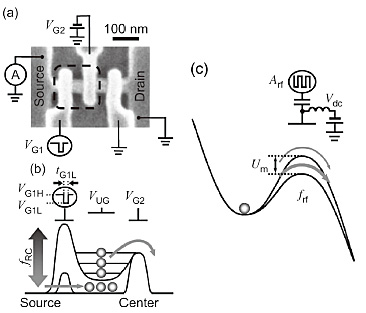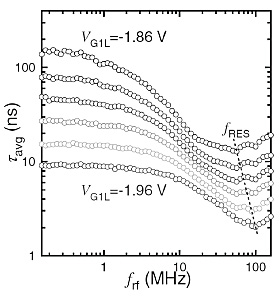Kohei M. Itoh2, and Akira Fujiwara1
1Physical Science Laboratory, 2Keio University
Single-electron (SE) transfer device has been investigated from the viewpoints
of its application to metrological current standards and low power circuits.
At relatively high temperatures the device is also a good platform to study
the dynamics of Brownian particles. In this work we address resonant activation
of a particle over an oscillating barrier [1], which is known as one of
the resonant phenomena for classical particles. Such resonance is predicted
to occur when the oscillation frequency satisfies the condition of scale
matching with the average rate of the particles crossing the barrier. Until
now only the resonant activation of macroscopic variables has been observed
in tunnel diodes and Josephson junctions.
The measured device consists of a silicon nanowire with multiple finger
gates as shown in Fig. 1 (a). Figure 1 (b) describes how the SE transfer
is performed using a SE ratchet [2] scheme, which enables clocked transfer
of SEs from source to drain via a charge island. Using proper gate voltages,
we can create a situation where a SE in the island is thermally activated
over a potential barrier as shown in Fig. 1(c). Then we apply a small rf signal Arf with a frequency frf to introduce a modulation Um to the barrier. The SE transfer is performed at 16 K with the ratchet
clock frequency of fRC=16.6 MHz. The average escape time τavg is evaluated by measuring the transfer current by varying the ejection time tG1L during which the electron is thermally activated over the barrier. Figure
2 shows τavg as a function of frf at different gate voltages VG1L which are used to change the order of τavg. τavg is found to manifest a resonance at a frequency with the same order of 1/τavg. Furthermore, the resonant frequency fRES exhibits a shift to higher frequencies for a shorter τavg. These behaviors are well explained in the framework of the resonant activation
which happens due to the synchronization between the deterministic rf signal and the stochastic escape of a single electron as a Brownian particle
[3].
[1] C. R. Doering and J. C. Gadoua, Phys. Rev. Lett. 69 (1992) 2318.
[2] A. Fujiwara, K. Nishiguchi, and Y. Ono, Appl. Phys. Lett. 92 (2008) 042102.
[3] S. Miyamoto et al., Phys. Rev. B 82 (2010) 033303.
 |
 |
|||||
|
|